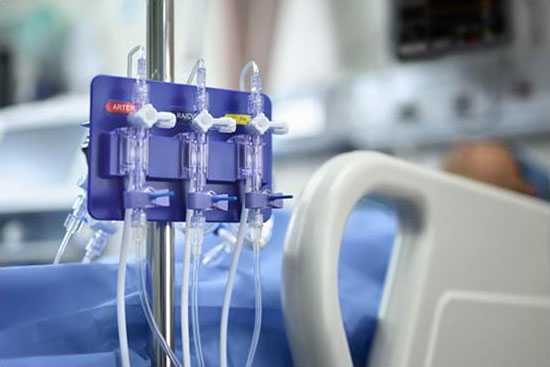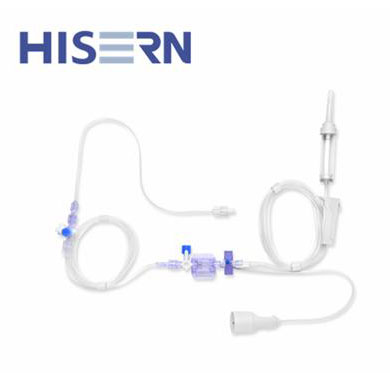Invasive blood pressure monitoring procedures
This technique measures arterial pressure directly by inserting a cannula needle into the appropriate artery. The catheter must be connected to a sterile, fluid-filled system connected to an electronic patient monitor.
In order to measure blood pressure correctly using an arterial catheter, the experts propose a systematic 5-step method that assists in (1) selecting the insertion site, (2) selecting the type of arterial catheter, (3) placing the arterial catheter, (4) level and zero sensors, and(5)checking the quality of the BP waveform.

During operation, it is necessary to prevent air from entering and causing embolism; Careful selection of suitable vessels and puncture sheath/radial artery sheath is also required. Postoperative effective nursing to prevent the occurrence of complications is very important, these complications include:(1) hematoma, (2) Infection of puncture site, (3) Systemic infection (4) arterial thrombosis, (5) Distal ischemia, (6) Local skin necrosis, (7) Arterial joint loosening caused blood loss, etc.
Which methods can be used to enhance care
1. After successful catheterization, keep the skin at the puncture site dry, clean and free from oozing blood. Replace 1 times daily apply, there is bleeding at any time disinfection replacement at any time.
2. Strengthen clinical monitoring and monitor body temperature 4 times a day. If the patient has high fever, chills, should be timely search for the source of infection. lf necessary, tube culture or blood culture is taken to assist diagnosis, and antibiotics should be properly used.
3. The catheter should not be placed for too long, and the catheter should be removed immediately once there are signs of infection. Under normal circumstances, the blood pressure sensor should be kept for no more than 72 hours and the longest one week. If it is necessary to continue. the pressure measurement site should be replaced.
4. Replace the heparin diluent connecting the tubes every day. Prevent intraductal thrombosis.
5. Closely observe whether the color and temperature of the distal skin of the arterial puncture site are abnormal. If liquid extravasation is found, the puncture site should be pulled out immediately, and 50% magnesium sulfate should be wet applied to the red and swollen area, and infrared therapy can also be irradiated.
6. Local bleeding and hematoma : (1) when the puncture fails and the needle is pulled out, the local area can be covered with gauze ball and wide adhesive tape under pressure.the center of pressure dressing should be placed at the needle point of the blood vessel, and the local area should be removed after 30 minutes of pressure dressing if necessary. (2) After surgery. the patient was asked to keep the limps straight on the operative side. and pay attention to local observation if the patient has activities in the short term to prevent bleeding. Hematoma can be 50% magnesium sulfate wet compress or spectral instrument local irradiation needle and test tube should be fixed firmly, especially when the patient is agitated, should strictly prevent their own extubation.(3) The connection of the arterial pressure tube must be closely connected to avoid bleeding after disconnection.
7. Distal limb ischemia:
(1) The collateral circulation of the intubated artery should be confirmed before surgery, and puncture should be avoided if the artery has lesions.
(2) Choose appropriate puncture needles, usually 14-20g catheter for adults and 22-24g catheter for children. Do not be too thick and use them repeatedly.
(3) Maintain the good performance of the tee to ensure the dripping of heparin normal saline; In general, every time arterial blood is extracted through the pressure tube, it should be immediately rinsed with heparin saline to prevent clotting. In the process of pressure measurement. blood sample collection or zero adjustment, it is necessary to strictly prevent intravascular air embolism.
(4) When the pressure curve on the monitor is abnormal, the cause should be found. If there is blood clot blocked in the pipeline, it should be removed in time. Do not push the blood clot in to prevent arterial embolism.
(5) Closely observe the color and temperature of the distal skin of the operative side, and dynamically monitor the blood flow of the hand through the blood oxygen saturation of ipsilateral finger. Extubation should be timely when abnormal changes of ischemia signs such as pale skin, temperature drop, numbness and pain are found.
(6) If the limbs are fixed,do not wrap them in a ring or wrap them too tightly.
(7) The duration of arterial catheterization is positively correlated with thrombosis. After the patient's circulation function is stable, the catheter should be removed in time, generally no more than 7 days.
Disposable pressure transducer
Introduction:
Provide consistent and accurate readings of arterial and venous blood pressure measurements
Features:
● Kit options (3cc or 30cc) for both adult/pediatric patients.
● With single,double and triple lumen.
● Available with closed blood sampling system.
● 6 connectors and various cables match most monitors in the world
● ISO, CE & FDA 510K.

Post time: Aug-03-2022




